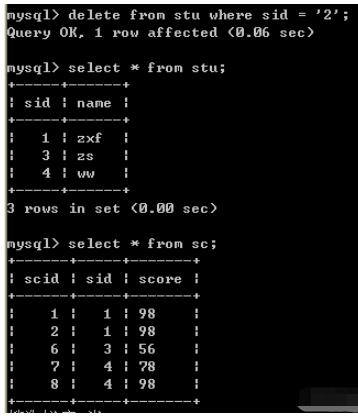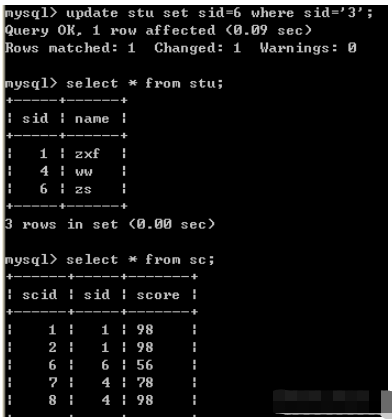How to implement MySQL foreign key cascade
Introduction
MySQL foreign keys play a constraint role and ensure data integrity at the database level.
For example, using the CASCADE (cascade concatenation) type of foreign keys, when a child table (such as user_info) is associated with a parent table (such as user), when the parent table is updated or deleted, the child table will update or delete records. This process is a database level completed.
There are many database designs in early enterprise systems. Although it helps programmers save delete and update operations, it actually increases hidden rules, increases software complexity, and weakens performance.
So in application design, we should try our best to ensure data integrity at the application layer (such as using transaction processing mechanism), rather than at the database level.
The following is an introduction to MySQL’s foreign keys.
The only storage engine that supports foreign keys in MySQL is InnoDB. When creating a foreign key, it is required that the parent table must have a corresponding index. Sub tableThe corresponding index will also be automatically created when creating foreign key.
When creating an index, you can specify the corresponding operations on the child table when deleting or updating the parent table, including
RESTRICT (restrict restriction)
NO ACTION
SET NULL
CASCADE (Concatenation)
RESTRICT is the same as NO ACTION, which means that when the child table has related records, the parent table cannot be updated;
CASCADE means parent tableWhen updates or deletes , updates or deletes the corresponding records of the child table ;
SET NULL means that when the parent table updates or deletes, the corresponding fields of the child table is SET NULL.
Example
Because only the InnoDB engine allows the use of foreign keys, our data table must use the InnoDB engine.
Create database:
Create database test;
1. First create two tables stu,sc
create table stu( sid int UNSIGNED primary key auto_increment, name varchar(20) not null) TYPE=InnoDB charset=utf8; create table sc( scid int UNSIGNED primary key auto_increment, sid int UNSIGNED not null, score varchar(20) default '0', index (sid), --外键必须加索引 FOREIGN KEY (sid) REFERENCES stu(sid) ON DELETE CASCADE ON UPDATE CASCADE) TYPE=InnoDB charset=utf8;
–Note: Foreign keys must be indexed;
FOREIGN key(sid) sets the foreign key, and sets sid as the foreign key
REFERENCES stu(sid) reference function. Reference the sid in the stu table
ON DELETE CASCADE cascade delete
ON UPDATE CASCADE cascade update
2. Insert data into two tables
insert into stu (name) value ('zxf'); insert into stu (name) value ('ls'); insert into stu (name) value ('zs'); insert into stu (name) value ('ww'); insert into sc(sid,score) values ('1','98'); insert into sc(sid,score) values ('1','98'); insert into sc(sid,score) values ('2','34'); insert into sc(sid,score) values ('2','98'); insert into sc(sid,score) values ('2','98'); insert into sc(sid,score) values ('3','56'); insert into sc(sid,score) values ('4','78'); insert into sc(sid,score) values ('4','98');

Note: When inserting data into the sc table, if the inserted sid is 22, the insertion will fail, violating the foreign key constraint, because the foreign key sid
comes from the primary key of id in the stu table. That is, the id in stu does not have data equal to 22.
Cascade deletion: Delete the student with id 2 in the stu table, and the student’s grades in the sc table will also be cascade deleted
delete from stu where sid = '2';

Cascade update: The student with id 3 in the stu table is changed to id 6, and the corresponding id of the student in the sc table will also be updated in cascade
update stu set sid=6 where sid='3';

Note
When deleting a table, you must first delete the foreign key table (sc), and then delete the primary key table (stu)

The above picture violates the foreign key constraint and cannot be Delete

#The picture above shows normal deletion. Delete the sc table first, and then delete the stu table!
The above is the detailed content of How to implement MySQL foreign key cascade. For more information, please follow other related articles on the PHP Chinese website!

Hot AI Tools

Undresser.AI Undress
AI-powered app for creating realistic nude photos

AI Clothes Remover
Online AI tool for removing clothes from photos.

Undress AI Tool
Undress images for free

Clothoff.io
AI clothes remover

Video Face Swap
Swap faces in any video effortlessly with our completely free AI face swap tool!

Hot Article

Hot Tools

Notepad++7.3.1
Easy-to-use and free code editor

SublimeText3 Chinese version
Chinese version, very easy to use

Zend Studio 13.0.1
Powerful PHP integrated development environment

Dreamweaver CS6
Visual web development tools

SublimeText3 Mac version
God-level code editing software (SublimeText3)

Hot Topics
 1387
1387
 52
52
 How to open phpmyadmin
Apr 10, 2025 pm 10:51 PM
How to open phpmyadmin
Apr 10, 2025 pm 10:51 PM
You can open phpMyAdmin through the following steps: 1. Log in to the website control panel; 2. Find and click the phpMyAdmin icon; 3. Enter MySQL credentials; 4. Click "Login".
 MySQL: An Introduction to the World's Most Popular Database
Apr 12, 2025 am 12:18 AM
MySQL: An Introduction to the World's Most Popular Database
Apr 12, 2025 am 12:18 AM
MySQL is an open source relational database management system, mainly used to store and retrieve data quickly and reliably. Its working principle includes client requests, query resolution, execution of queries and return results. Examples of usage include creating tables, inserting and querying data, and advanced features such as JOIN operations. Common errors involve SQL syntax, data types, and permissions, and optimization suggestions include the use of indexes, optimized queries, and partitioning of tables.
 How to use single threaded redis
Apr 10, 2025 pm 07:12 PM
How to use single threaded redis
Apr 10, 2025 pm 07:12 PM
Redis uses a single threaded architecture to provide high performance, simplicity, and consistency. It utilizes I/O multiplexing, event loops, non-blocking I/O, and shared memory to improve concurrency, but with limitations of concurrency limitations, single point of failure, and unsuitable for write-intensive workloads.
 MySQL's Place: Databases and Programming
Apr 13, 2025 am 12:18 AM
MySQL's Place: Databases and Programming
Apr 13, 2025 am 12:18 AM
MySQL's position in databases and programming is very important. It is an open source relational database management system that is widely used in various application scenarios. 1) MySQL provides efficient data storage, organization and retrieval functions, supporting Web, mobile and enterprise-level systems. 2) It uses a client-server architecture, supports multiple storage engines and index optimization. 3) Basic usages include creating tables and inserting data, and advanced usages involve multi-table JOINs and complex queries. 4) Frequently asked questions such as SQL syntax errors and performance issues can be debugged through the EXPLAIN command and slow query log. 5) Performance optimization methods include rational use of indexes, optimized query and use of caches. Best practices include using transactions and PreparedStatemen
 Why Use MySQL? Benefits and Advantages
Apr 12, 2025 am 12:17 AM
Why Use MySQL? Benefits and Advantages
Apr 12, 2025 am 12:17 AM
MySQL is chosen for its performance, reliability, ease of use, and community support. 1.MySQL provides efficient data storage and retrieval functions, supporting multiple data types and advanced query operations. 2. Adopt client-server architecture and multiple storage engines to support transaction and query optimization. 3. Easy to use, supports a variety of operating systems and programming languages. 4. Have strong community support and provide rich resources and solutions.
 Monitor Redis Droplet with Redis Exporter Service
Apr 10, 2025 pm 01:36 PM
Monitor Redis Droplet with Redis Exporter Service
Apr 10, 2025 pm 01:36 PM
Effective monitoring of Redis databases is critical to maintaining optimal performance, identifying potential bottlenecks, and ensuring overall system reliability. Redis Exporter Service is a powerful utility designed to monitor Redis databases using Prometheus. This tutorial will guide you through the complete setup and configuration of Redis Exporter Service, ensuring you seamlessly build monitoring solutions. By studying this tutorial, you will achieve fully operational monitoring settings
 How to view sql database error
Apr 10, 2025 pm 12:09 PM
How to view sql database error
Apr 10, 2025 pm 12:09 PM
The methods for viewing SQL database errors are: 1. View error messages directly; 2. Use SHOW ERRORS and SHOW WARNINGS commands; 3. Access the error log; 4. Use error codes to find the cause of the error; 5. Check the database connection and query syntax; 6. Use debugging tools.
 How to connect to the database of apache
Apr 13, 2025 pm 01:03 PM
How to connect to the database of apache
Apr 13, 2025 pm 01:03 PM
Apache connects to a database requires the following steps: Install the database driver. Configure the web.xml file to create a connection pool. Create a JDBC data source and specify the connection settings. Use the JDBC API to access the database from Java code, including getting connections, creating statements, binding parameters, executing queries or updates, and processing results.




